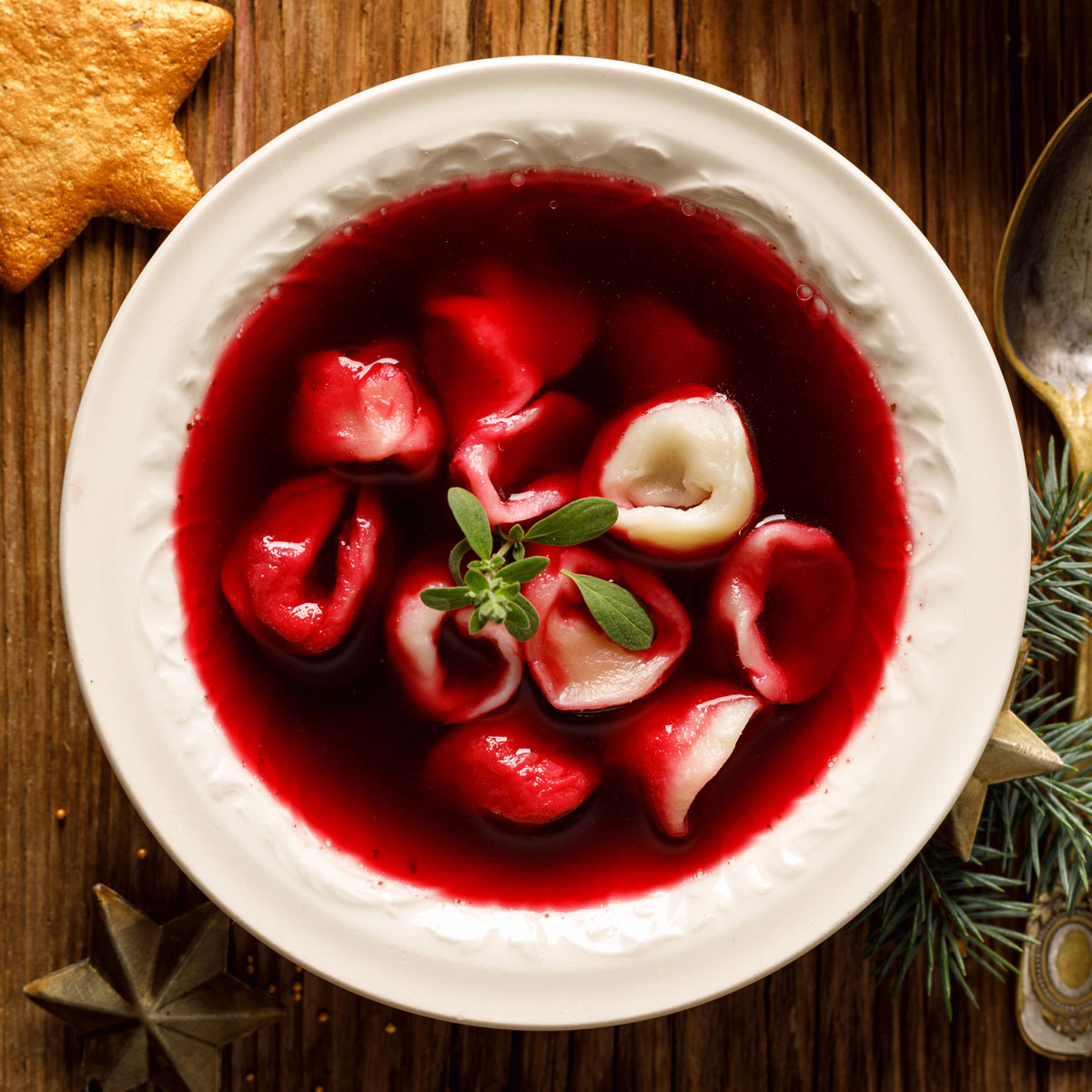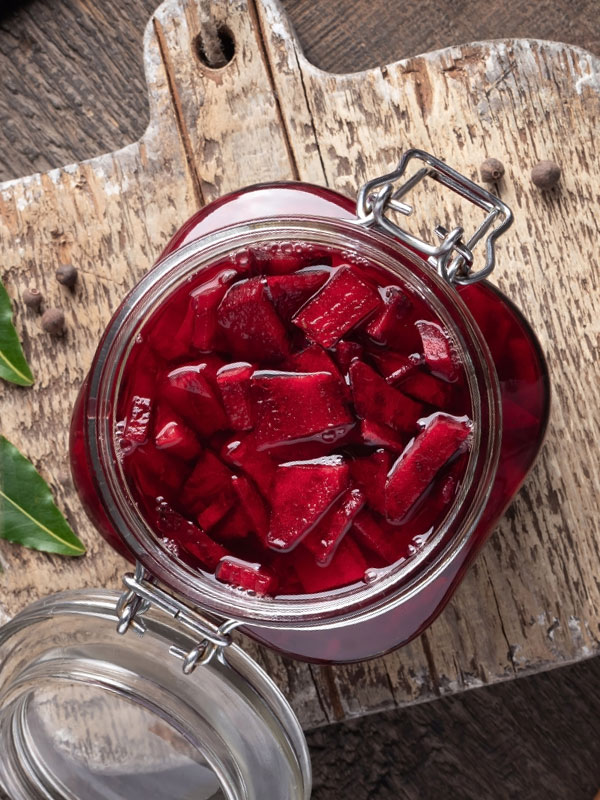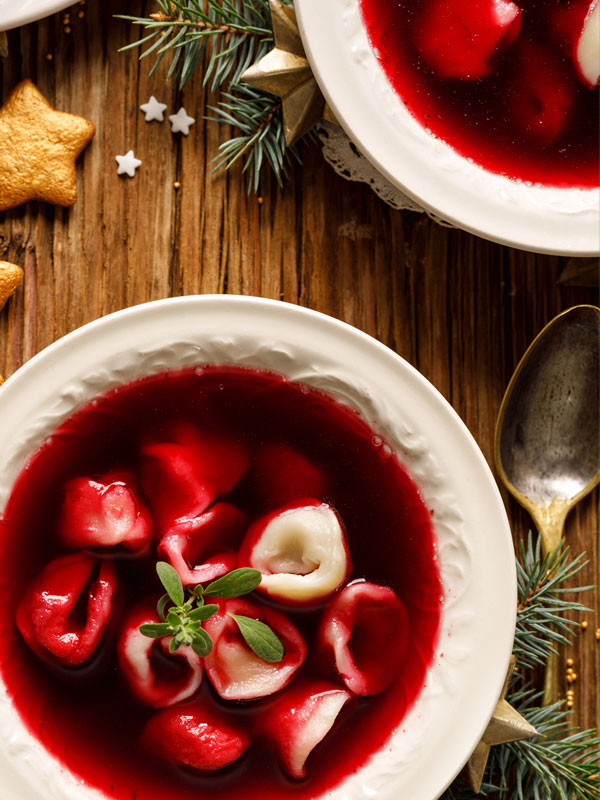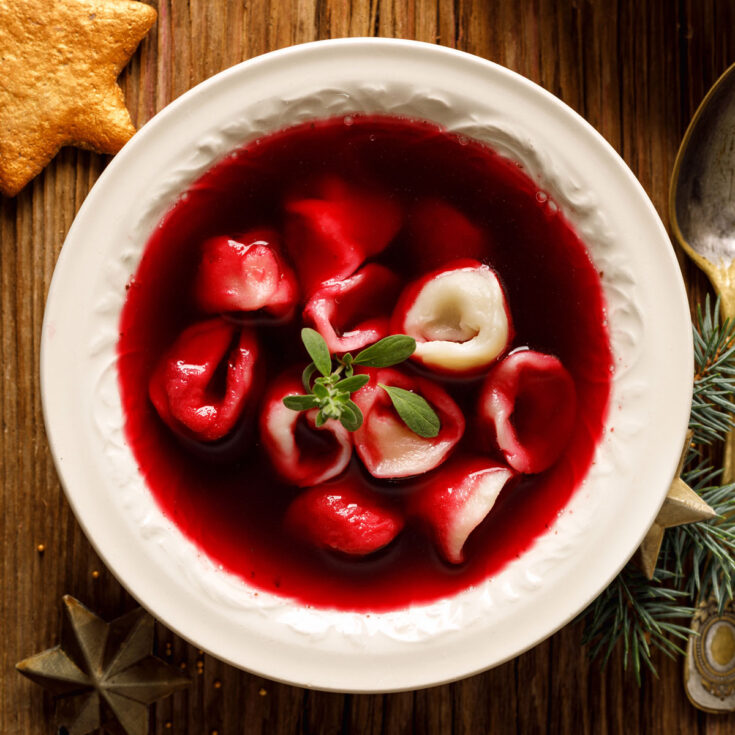Barszcz Czerwony Wigilijny, na Zakwasie
Barszcz Czerwony: Polish Red Borscht for Christmas Eve Dinner
How to pronounce it?
barshch tsher-vony
‘Play’ to hear:

Allow me to start with a brief clarification concerning the terminology. While I typically refrain from using the spelling ‘Borscht,’ it seems to be the most commonly searched term for the name of this soup online. Therefore, it is occasionally used here to ensure you can find this recipe. Hopefully, over time, the Polish spelling will gain wider acknowledgement.
This festive Barszcz Czerwony is a rich, earthy beet soup – and a star of the Christmas Eve dinner table.
Its secret lies in fermented beet zakwas and proper vegetable stock. To pump up the festive aromas even more, we’re adding dried wild mushrooms, marjoram, smoked prunes and juniper berries.
For the full list of ingredients & detailed instructions, please see the recipe card at the end of this post. But before you scroll, there’s important stuff to know below.
Polish Christmas Eve dinner is traditionally meat- and dairy-free, and so this Red Borscht follows this custom as well.
Do you need any special ingredients to make this Red Borscht?
Yes, there’s a key ingredient that cannot be easily replaced – Fermented Beetroot Juice, or what we call ‘Zakwas Buraczany’ in Polish.
It’s unlikely you’ll find it available outside of Poland, although you could try asking in a Polish Deli. Luckily, it’s very easy to make at home.

Here’s a detailed recipe for a homemade Beet Kvass / Zakwas (👈 click for a recipe).
Some home cooks try to use vinegar as a substitute, but please don’t go that route. The difference in taste is massive. Instead of subtle, earthy notes of beets, you get an unpleasant acidic hit of vinegar – not cool.
How should you serve this Beet Borscht?
Here in Poland, various Beet Borscht soups are very popular and served for lunch or dinner throughout the year.
But this specific recipe is a bit more special – it’s traditionally a part of the twelve-dish Christmas Eve supper. Since no meat or dairy is allowed that night, this Borscht is completely vegan.
The soup is served with one (or more) of the following sides:
- ‘Uszka’ – tiny dumplings
- ‘Paszteciki’ – small yeast pasties
- ‘Kulebiak’- large stuffed pastry (known as coulibiac)
- ‘Krokiety’ – Polish-style croquettes (breaded crêpes/thin pancakes with filling)
All of the above are filled with meat-free stuffing, usually with wild mushrooms and/or sauerkraut.
If you’re not up for an elaborate side dish, here’s an idea: serve this soup with baguette slices, buttered and topped with pan-fried slices of white mushrooms.
Can you make this Christmas Borscht another way?
Yes, you can cook it quicker.
I like to roast all the vegetables first, because that makes the stock richer and more fragrant. But you can skip the whole roasting process and drop all the veggies straight into a pot with water. That’s how it’s done in most recipes.
If you’re not avoiding meat, you can use a meat stock instead. Poultry, beef, anything goes.
What diets is this Red Borscht soup suitable for?
Just like all recipes for a Polish Christmas Eve, this recipe is suitable for vegans (it’s meat, dairy and egg-free). The soup itself is gluten-free as well, but the most popular side dishes contain grains.
How long can you keep this Red Borscht in the fridge?
Once the soup is served, ideally you should eat it within 3 hours.
To store, allow the leftovers to cool and refrigerate in a container with a lid. You can keep leftovers of Red Borscht in the fridge for up to 7 days.
Can I freeze this Vegan Borscht?
Yes, you can – but consider if it’s worth it, because:
- The soup stores well in the fridge (for up to 7 days), and…
- The key ingredient (Beet Kvass / Zakwas) can be made weeks in advance. That means you can ferment the beets first, and then cook the rest on Christmas Eve (or a day before).
When freezing Red Borscht, make sure to do so as soon as it cools down completely. Pour it into a freezer-friendly container and label it with a description and the date.
How do I reheat this Red Borscht?
When reheating this soup, avoid microwaving or bringing the soup to a boil. It causes a loss of flavour and a loss of the lovely, burgundy colour. The friendly bacteria (from fermented beets) die in high temperatures as well.
From chilled: Pour the soup into a cooking pot and reheat over “low” heat. Make sure it doesn’t boil, and switch it off after the very first signs of ‘bubbling’. Serve warm.
From frozen: Thaw the soup in the fridge overnight. Reheat as outlined above, slowly, over low heat until hot – but not boiling.

Polish Red Borscht Soup for Christmas Eve (Wigilijny Barszcz Czerwony)

This Christmas Eve Red Borscht - served in teacups or with little 'Uszka' dumplings - is one of the most Polish soups. It’s a shining star on the Christmas Eve dinner table.
Ingredients
- 0.9 lb (400 g) beetroots
- 2 carrots (5.5 oz, 160 g)
- 2 parsley roots (5.5 oz, 160 g), can substitute for celery root
- 0.5 lb (220 g) white mushrooms
- 1 leek
- ¼ celery root (3 oz, 85 g)
- 1 onion, any colour
- 2 garlic cloves
- ½ apple
- 4-5 thyme or rosemary sprigs
- 1 tbsp oil, olive oil or other
- 3-4 tbsp white wine, can substitute for water
- 4 bay leaves
- 4 allspice berries
- 4 juniper berries
- 2 cloves
- 2 smoked prunes, can substitute for regular prunes
- 10 dried wild mushrooms (e.g. porcinis)
- 1 lq qt (1 litre) water
- 2 cups (roughly 500-600 ml) beet kvass/fermented beet juice, 1 portion from this recipe
- 1 tsp dried marjoram
- Black pepper, to taste
- Salt, to taste
Instructions
- Preheat the oven to 425°F (220°C).
- Thoroughly scrub the vegetables (beetroots, carrots, parsley roots, mushrooms, leek). Peel the celery root and the onion, leave the rest of the vegetables (and a half an apple) in the peel. Chop the veggies into chunks.
- Grab a large roasting pan, pour a tablespoon of oil in. Toss all the mushrooms, veggies, herb sprigs and garlic together into the roasting pan.
- Roast in the middle of the oven for 30 to 40 minutes, turning occasionally, until vegetables turn golden brown.
- Move the roasting pan onto the stove burner, over a medium heat. Add a few glugs of white wine to deglaze the pan (stirring and scraping up the brown bits for 2-3 minutes).
- Transfer everything into a cooking pot. Pour in 1 quart / 1 litre of water in, bring to a boil and reduce the heat to “low”.
- Add bay leaves, allspice & juniper berries, cloves, smoked prunes and dried wild mushrooms.
- Cover the pot with a lid (I’m leaving a small gap) and cook for at least an hour.
- Pour the stock through a large fine sieve into another pot (or a large bowl), firmly pressing on to push out as much stock as possible. Skim off the fat.
- The soup is supposed to be clear, therefore we won’t need the remaining vegetables. You can reuse them in another dish, but there won’t be much flavour left in them. I usually sneak out one or two of those ultra soft carrots and beetroot pieces before discarding the rest.
- Pour in 2 cups of beet kvass / zakwas into a large cooking pot. You can skip the fermented beets, but I add them in. Pour in 3 cups (¾ litre) of the stock we just cooked.
- Add in one teaspoon of dried marjoram and generously season with black pepper. Cook together on the lowest heat for 3-4 minutes, stirring occasionally. Have a taste - if it’s too strong, add a little bit more stock.
- Cook together for another 30 minutes on a very low heat, making sure the soup doesn’t boil at any point.
- Remove beetroots (if you added any with your beet zakwas), season with salt and pepper if necessary. If the flavour is too sour, add a little bit of sugar. You can use the remaining beetroot pieces as a garnish (optionally).
- Serve warm, on its own or with 'Uszka' dumplings.
Notes
Nutrition Information:
Yield:
4Serving Size:
1Amount Per Serving: Calories: 369Total Fat: 9gSaturated Fat: 1gTrans Fat: 0gUnsaturated Fat: 7gCholesterol: 0mgSodium: 265mgCarbohydrates: 65gFiber: 17gSugar: 32gProtein: 8g
Polonist is reader-supported. When you buy through links on our site, we may earn a small affiliate commission. Learn more
Recipe Information
Filed under:
Alternative traditional/regional names:
Barszcz Wigilijny, Barszcz Czysty, Barszcz Postny
Also known / Misspelt internationally as:
Polish Borscht Soup, Polish Borsch, Polish Red Borscht, Polish Christmas Borscht, Polish Beet Soup, Red Beet Soup
Tested by:
First published on:
Recipe by / Adapted from:
Story by:
Bibliography / References: